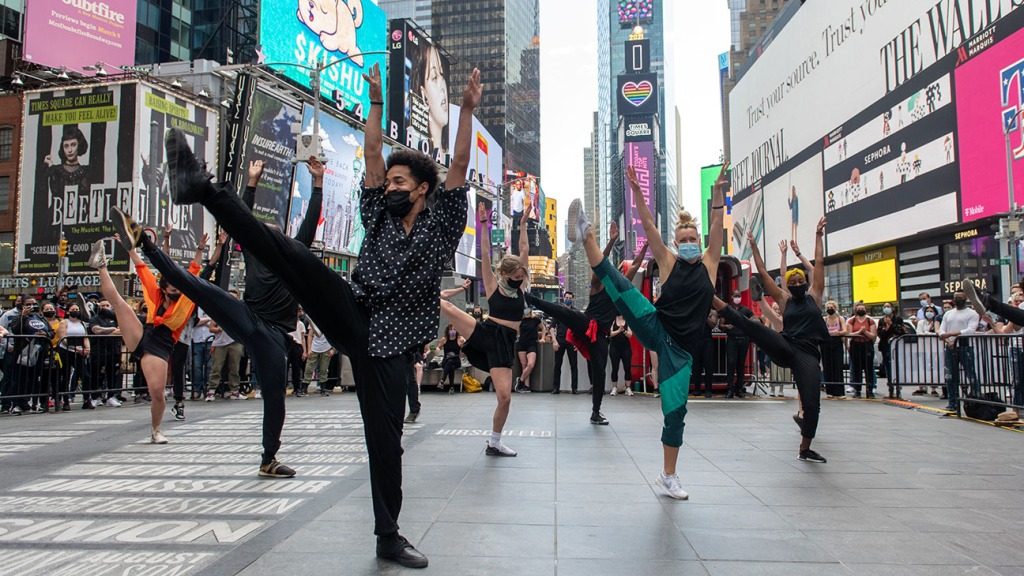
Actors’ Equity is taking another step forward in bringing back in-person auditions for theater performers.
For the first time since the pandemic began, the actors’ and stage managers’ union will reopen its audition centers in Chicago, New York and Los Angeles starting Nov. 17. This is meant to encourage more producers to hold in-person calls, ahead of a coming mandate, after some performers expressed frustration with virtual auditions due to the cost involved and the feeling that their tapes were not being watched.
Dancers, in particular, have been pushing for a bigger return to in-person auditions. Megan Bowen, a New York-based dancer and actor, said she found that she had to rent studio space to audition for virtual dance calls. It wasn’t a requirement, per se, but many casting calls would not accept pretaped dance reels and were asking for original choreography or dance combinations that required a larger space than a New York City apartment.
Renting studio space by the hour added up to about $2,000 across the first two years of the pandemic. Due to the cost, as well as the feeling of submitting tapes into a void — Bowen said she would not receive any indication that the work had been received and, in some cases, could see that it had not been downloaded or viewed — she decided to stop auditioning for most virtual calls at the beginning of 2022. (Bowen is not an Equity member, but was able to submit for these auditions).
“I was just getting frustrated and angry and feeling like my work wasn’t being seen,” Bowen said.
Equity member Heather Klobukowski has also been renting studio space to submit audition tapes, after the noise of dancing at home was too disruptive for neighbors. In addition to the cost, which Klobukowski says is prohibitive for some members, she said she missed the energy of auditioning with other dancers. She’s been pushing Equity to require in-person for dance auditions, specifically, with self-tapes remaining an option for those who cannot attend in person for health conditions or other reasons.
Actors’ Equity initially set protocols for a return to in-person auditions in March 2022 (giving producers a choice on whether to do them virtually or in-person and with the requirement that they find their own studio space). The protocols apply to Equity Principal Auditions and Equity Chorus Calls only, which are auditions Broadway producers are contractually required to hold on a regular basis and the only ones regulated by Equity.
The new Equity rules, which come along with the reopening of the centers and staff to monitor auditions, lessen some of the COVID-19 restrictions that had previously been in place, while still requiring six feet of distance between performers and prohibiting partnered dancing.
Producers can still continue to hold video auditions for these calls through Dec. 31, but must return to holding some form of in-person auditions starting Jan. 1. Other types of auditions are up to the producer’s discretion.
The goal in reopening the audition centers and creating these new rules was to pave a return to the old model of auditioning, in which performers could be certain that they were being seen because they were physically in front of the creative team.
“What we want to do is we want to create real access in the way that we believe we’ve always done it,” said Rashaan James II, an Equity council member who helped create the regulations.
While casting directors Benton Whitley and Duncan Stewart say they understand performers’ frustration with virtual auditions (which they note they “absolutely do” watch), they say there are many benefits. The ability to hold auditions remotely, in general, has allowed them to increase the number of people they see per day.
In the case of open calls, Whitley and Stewart say they’re now able to view 300 to 500 tapes, versus the 80 to 100 people they would have seen in a day for an in-person session. Almost all of their first-round auditions have gone virtual.
“They are getting more opportunities to actually audition now than they used to, because we are able to audition more people than we used to. And so there’s many different ways that you can look at this,” Whitley said.
For the required dance calls, particularly on Chicago and Hadestown (two shows cast by the Stewart/Whitley office), the casting directors say they have tried to make sure that the choreography can be done within a limited space. Many of their self-tapes have been submitted from living rooms with couches pushed back, from fitness studios within gyms and even from the street, they said.
The required auditions for Chicago and Hadestown returned to in-person over the past two months, and Stewart and Whitley expect to use a mixture of in-person and virtual moving forward.
For other types of auditions, the virtual-hybrid model appears here to stay.
Over the past several months, callbacks have taken place in the form of in-person auditions, after an initial virtual screening. But even then, the casting team in the room has often had to pull out a laptop for a Zoom audition because a performer has caught or been exposed to COVID-19, Whitley said.
The move to virtual has increased work hours for casting directors (“My living room is now an audition space almost 24/7. I’m always watching tapes in my living room. I’m looking at tapes as I’m making cereal in the morning in my kitchen,” Stewart said), but has also expanded audition opportunities to performers who are not based in New York. Bowen and Klobukowski also agree that the virtual model appears to be beneficial for acting and singing auditions.
This marks a paradigm shift in an industry in which taped auditions weren’t previously a big consideration for directors and producers, Whitley noted, since the emphasis is on “live theater.”
“This kind of transitional period has taught all of us that there is actually a massive advantage and opportunity to see people virtually,” added Whitley. “The learning has been long, but I think that we all agree, young and old in our industry, that there’s a place for it and it’s not going to go anywhere.”

